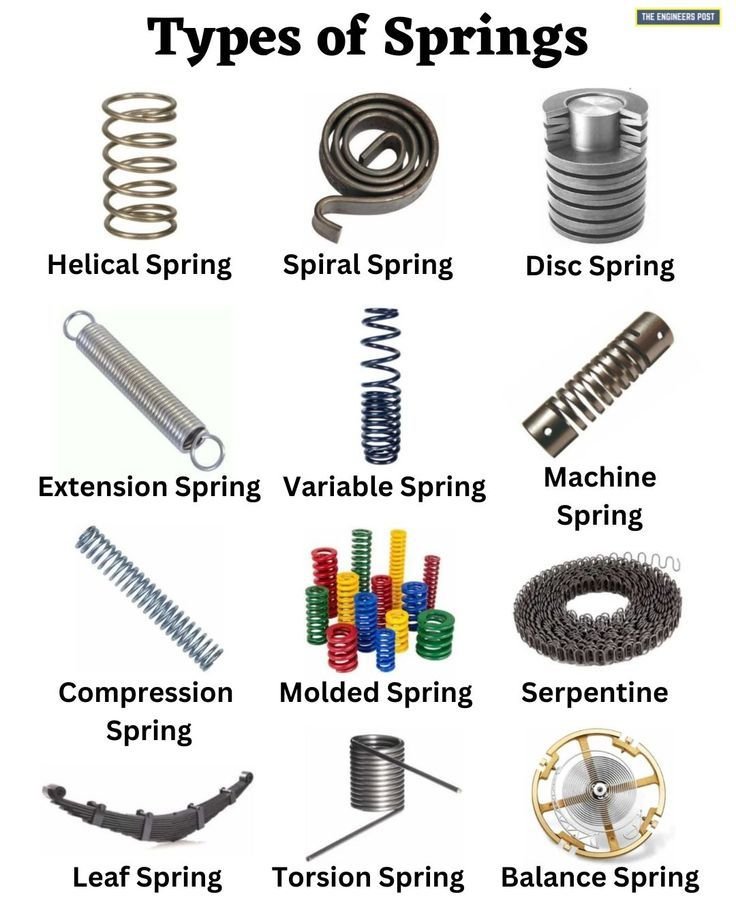
Home » Types of springs
Springs are mechanical devices that store and release energy through their elasticity. They are used in a variety of applications, from industrial machinery to everyday household items. This guide covers the different types of springs, their manufacturing materials, and their applications.
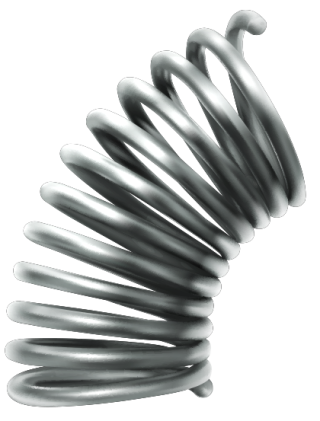
Springs vary in material, shape and function, so their uses are also varied. There are three main types of springs, each of which can be divided into different sub-categories.
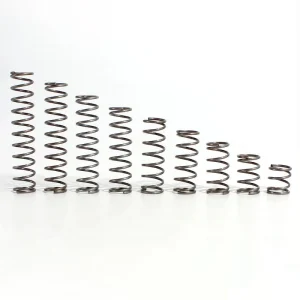 Compression Springs
Compression SpringsWhen compressed, open-coil helical springs known as compression springs produce a reaction force. The distance between the coils steadily gets smaller as the load increases until the spring’s maximum compressed length is reached, at which time the coils come into contact with one another. The spring’s ends can be left open or closed; the closed end is formed by pressing the final coil flat against the coil next to it. Another way to mold them into a square is to grind the ends flat.
Applications: When a reaction force is needed between components, compression springs are frequently utilized. Typical uses are as follows:
Shock absorption is a feature of automotive suspension systems that enhance ride comfort.
Ballpoint pens: Compression springs push the tip out when the pen is released after contracting when the tip is squeezed.
Mechanical equipment: To prevent damage from stress and vibration, provide cushioning and shock absorption.
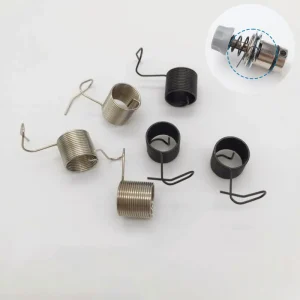 Tension Springs
Tension SpringsWhen stretched, extension springs—also referred to as tension springs—produce a reaction force. Though they can be altered upon request, they typically have loop or hook ends. Their use is primarily restricted to non-critical applications due to their ability to be stretched past their breaking point.
Applications: Extension springs find extensive usage in a diverse range of mechanisms and gadgets. Typical uses are as follows:
Extension springs provide trampolines their elasticity and rebound force.
Garage doors: Garage door balance systems facilitate the raising and lowering of doors.
Toys: The driving force in clockwork toys is provided by extension springs.
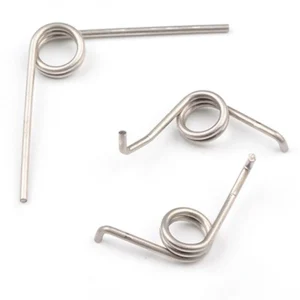 Torsion springs
Torsion springsTo apply or resist torque loads, one uses torsion springs. The two types of springs that they belong to are helical torsion springs and non-helical torsion springs. Helical torsion springs exert force radially instead of axially, making them comparable to compression and extension springs. Helical torsion springs are mostly employed in motion control devices in many forms of machinery. They are constructed of flat or rectangular material twisted into concentric spirals.
Applications: In manufacturing applications, torsion springs are frequently utilized as motion control components.
Door hinges: Provide automated closing mechanisms and regulate the force used to open and close doors.
Torsion springs supply the catching force in mousetraps.
Mechanical devices: These include motion control units in industrial machines, clothespins, car seat belts, clocks, and seat recliners.
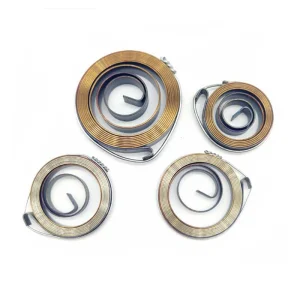 Constant force springs
Constant force springsClocks and clockwork toys frequently use constant force springs. They are steel strips that have been tightly twisted; they resemble rolls of tape. The strip extends as a load is applied, and its intrinsic stress continuously opposes the force of the load.
Applications: Constant force springs are useful in a variety of situations where a constant force is needed. Examples of these situations are as follows:
Clocks: Offer a steady force to guarantee precise timekeeping.
Wind-up toys: Constant force springs provide a driving power for continual motion.
Curtain roller blinds: To maintain taut and sturdy curtains in place, use constant tension springs.
An overview of compression, extension, torsion, and constant force springs, along with their various uses, is provided above. These springs are essential to many everyday and industrial uses.
Mono leaf springs, also known as single-leaf springs, consist of a single layer of metal. This layer is usually tapered at each end to provide a more uniform bending characteristic.
Applications:
Lightweight vehicles: Due to their simple design and limited load-bearing capacity, mono leaf springs are typically used in lightweight vehicles such as small cars and trailers.
Motorcycles: In some motorcycle suspension systems.
Multi-leaf springs are composed of several metal layers, or “leaves,” stacked on top of each other. The leaves vary in length, with the longest leaf, known as the main leaf, on the top, and shorter leaves beneath it. These springs are more robust and can bear heavier loads compared to mono leaf springs.
Applications:
Heavy-duty trucks: Used in the suspension systems of trucks and commercial vehicles for their high load-bearing capacity.
Buses: Commonly used in the suspension systems of buses.
Off-road vehicles: Used in off-road vehicles for enhanced durability and load support.
Semi-elliptical leaf springs are one of the most common types of leaf springs. They have a characteristic semi-elliptical shape, where the leaves are arranged in a curved arc. This design allows for effective load distribution and improved ride quality.
Applications:
Passenger cars: Used in the rear suspension systems of many passenger cars.
Light commercial vehicles: Common in light commercial vehicles for better handling and load support.
Quarter-elliptical leaf springs are essentially half of a semi-elliptical leaf spring. They are mounted on one end to the frame of the vehicle and on the other end to the axle.
Applications:
Vintage cars: Often found in vintage and classic cars.
Custom and modified vehicles: Used in custom and modified vehicles for unique suspension setups.
Three-quarter elliptical leaf springs are a combination of semi-elliptical and quarter-elliptical leaf springs. They provide a greater range of motion and flexibility in the suspension system.
Applications:Heavy-duty and special-purpose vehicles: Used in certain heavy-duty and special-purpose vehicles for enhanced suspension capabilities.
Transverse leaf springs are mounted horizontally across the vehicle’s chassis, rather than longitudinally. This setup is less common but offers unique suspension characteristics.
Applications:
Sports cars: Used in some sports cars, such as older models of the Chevrolet Corvette.
Classic vehicles: Found in certain classic and vintage vehicles.
Parabolic leaf springs have leaves that are tapered in a parabolic curve rather than a linear one. This design reduces the interleaf friction, providing a smoother ride and improved flexibility.
Applications:
Modern trucks: Used in modern truck suspensions for better load distribution and ride quality.
Buses and commercial vehicles: Applied in buses and commercial vehicles for enhanced comfort and durability.
Standard disk springs are conical washers that deflect under a load, providing a precise, high-force output. They are typically used individually but can be stacked in series or parallel to achieve different load and deflection characteristics.
Applications
Industrial machinery: Used in clutches, brakes, and other high-load components.
Aerospace: Employed in aircraft assemblies for vibration damping and load distribution.
Automotive: Used in suspension systems, shock absorbers, and as preload washers.
Curved disk springs have a slightly curved shape, which provides a lower force but a longer deflection range compared to standard disk springs. They are often used for applications requiring lower, more consistent force.
Applications
Electrical contacts: Used to maintain consistent contact pressure.
Seals and gaskets: Employed to maintain seal integrity under varying pressure conditions.
Lightweight assemblies: Ideal for applications where space and weight are constraints.
Wave springs are disk springs with a wave-like structure, allowing them to provide a similar force to standard disk springs but with reduced height. They are ideal for applications requiring a compact form factor.
Applications
Bearing preload: Used to maintain consistent bearing load and reduce vibration.
Valve components: Employed in valve assemblies to provide consistent force.
Compact mechanisms: Ideal for use in confined spaces where traditional springs cannot fit.
Slotted disk springs have radial slots cut into the disk, reducing the spring rate and allowing for higher deflection. These springs provide a more flexible response compared to solid disk springs.
Applications
Load distribution: Used to evenly distribute loads in mechanical assemblies.
Thermal expansion compensation: Employed in systems where thermal expansion requires flexible components.
Vibration isolation: Effective in isolating vibrations in sensitive equipment.
Nested disk springs are multiple disk springs stacked in a nested configuration, where each spring fits inside the other. This setup increases the load capacity while maintaining a compact height.
Applications
Heavy machinery: Used in heavy-duty applications requiring high load capacity.
Construction equipment: Employed in construction machinery for load-bearing components.
Energy absorption: Ideal for applications requiring high energy absorption in a limited space.
Segmented disk springs are divided into segments, reducing the overall stress and providing a more uniform force distribution. They offer improved durability and performance under high load conditions.
Applications
High-stress environments: Used in environments where standard disk springs may fail due to high stress.
Shock absorbers: Employed in shock absorbers for enhanced durability.
Load balancing: Ideal for applications requiring precise load balancing.
Contact disk springs are designed with special contact points to improve electrical conductivity and reduce contact resistance. They are often used in electrical and electronic applications.
Applications
Electrical connectors: Used to ensure reliable electrical connections.
Circuit breakers: Employed in circuit breakers to maintain consistent contact pressure.
Battery contacts: Ideal for maintaining reliable connections in battery assemblies.
Springs can be made from a variety of materials, each with its own properties and suitability for different applications. Some common materials used for springs include:
1. Steel: This is one of the most widely used materials for springs. It offers good strength, durability, and resilience. Different types of steel such as carbon steel, alloy steel, and stainless steel are employed. Carbon steel is cost-effective and suitable for many general-purpose applications. Alloy steel provides enhanced strength and performance in more demanding conditions. Stainless steel is chosen for its corrosion resistance.
– For example, in automotive suspension systems, high-strength alloy steel springs are often used to withstand the constant stress and varying loads.
2. Music Wire: Also known as piano wire, it is a high-carbon steel wire with excellent tensile strength and fatigue resistance. It is commonly used in small precision springs.
– Small springs in mechanical watches often utilize music wire for its precise and reliable performance.
3. Bronze: It offers good corrosion resistance and electrical conductivity. Bronze springs are used in applications where these properties are important, such as in electrical contacts or marine environments.
4. Brass: Similar to bronze, brass has decent corrosion resistance and is sometimes used in springs where a non-ferrous material is preferred.
5. Titanium: Known for its lightweight and high strength-to-weight ratio, titanium springs are used in aerospace and high-performance applications where weight reduction is crucial.
– In some advanced aerospace components, titanium springs help minimize the overall weight of the system without sacrificing performance.
6. Nickel Alloys: These alloys provide excellent resistance to high temperatures and corrosion, making them suitable for springs used in extreme environments.
7. Plastics and Composites: In some cases, springs can be made from specialized plastics or composite materials. These offer advantages such as lightweight, chemical resistance, and electrical insulation. They are often used in lightweight and non-metallic applications.
– For instance, in certain medical devices or consumer electronics where non-conductive and lightweight springs are needed, plastic springs can be a suitable choice.
8. Elastomers: Materials like rubber or silicone can be used to create spring-like components that provide flexibility and shock absorption.
– In shock absorbers for small appliances or toys, elastomer-based springs can offer a simple and cost-effective solution.
other substances that can be used for making springs. These include various non-metallic materials like ceramics, which offer excellent heat resistance and hardness in specific high-temperature or abrasive environments. Fiberglass-reinforced composites can provide a combination of strength and lightweight properties for specialized applications. Some rare metals and their alloys might also be employed in very specific cases where unique properties such as extreme hardness or resistance to specific chemicals are necessary. The selection of these less common materials depends on highly specialized and often niche requirements of the particular spring application.
The choice of material for a spring depends on factors such as the required load capacity, operating environment, size constraints, and cost considerations.
Numerous spring coatings and metal surface treatments are available with a variety of objectives in mind, including wear resistance, corrosion prevention, enhanced spring performance, and all of the above. The following describes a variety of spring finishes:
Electropolishing
While the workpiece and the deposited (in this case, pick-up) material have the same polarity, the electropolishing method works on a similar basis to electroplating. This indicates that the pick-up metal acts as a cathode and the workpiece as an anode to complete the electrical circuit through the electrolyte.
Rapid removal of material from the raised and rough surface of the workpiece, or de-plating the spring in this case, results in a very smooth and polished surface. Electropolishing can produce a mirror finish with a surface roughness of less than 0.05 m if the original surface roughness is less than 0.18–0.20 m (micrometers).
Tumbling
The tumbling container, which holds plastic poly pellets in different grits, can rotate or vibrate to provide a tumbling finish. These grits correspond to the four stages of tumbling: grinding, smoothing, polishing, and shining.
We fill a tumbling container with parts, like springs, and cover it with poly pellets, also referred to as the media. When the medium is in use, it contacts the components and uses friction to polish the base material.
Shot Peening
The cold working process known as shot peening directs a high-velocity stream of bullets at the metal surface under closely regulated circumstances. As a result, the exposed metallic object layers experience compressive pressure, which greatly reduces the material’s tensile stresses and boosts its tensile strength.
People sometimes confuse shot peening with sandblast cleaning because the two processes are similar and shot peening also cleans the surface. However, the main goal of shooting is to increase the material’s fatigue strength. The peening media can be either iron, steel, glass shot, chopped steel, or stainless steel wire.
Electroplating
Electroplating uses electrical current to introduce plating material ions into the plating substrate, which is a spring. An electrolyte bath is used to hold both the plating material, which is attached to the anode, and the portion that needs to be plated, which is attached to the cathode. The electrolyte’s current flow drives the plating material’s ions into the plating substrate, applying a thin layer of the plating material to the part.
Carbon steels and alloy steels with either noble metals or non-corrosive metals are the most frequently plated material types. As long as the plating layer is intact, noble metal electroplating offers excellent protection against corrosion. Non-corrosive metals such as tin, nickel, and chromium frequently electroplate steels to provide corrosion protection. However, this type of coating rarely covers portions submerged in water, exposed to the environment, or exposed to another electrolyte.
Instead, people frequently use less noble materials like zinc or cadmium as a type of sacrificial anode that will oxidize in place of the substrate.
Electroless Plating
Electroless plating is a technique that coats a substrate in nickel without requiring electricity. Here, there is no anode; instead, the substrate acts as a catalyst to start a chemical reaction that reduces the nickel ions in the electrolyte solution and deposits them on the substrate. Apart from its catalytic role, the nickel coating ensures the continuous reaction until the substrate exits the electrolyte bath.
This enables the production of a relatively thick coating ranging from 20 m to 50 m. Furthermore, unlike electroplating, the electroless nickel plate is completely homogeneous and will fit into all nooks and crannies. While other metals can also undergo plating, nickel and its alloys are the most commonly used.
Chemical Coatings
Chemical treatments for metals, such as phosphoric acid washes, typically subject steel to restricted and transient oxidation protection. Paint coats can offer corrosion protection for an extended period of time. The least expensive way to create a barrier that resists corrosion on steel, stainless steel, or copper surfaces is by applying black oxide. In some applications, they’re also excellent at removing light reflections.
Room 401, Building C, No. 16 Wangjiao Road, Hengtang, Tangxia Town, Dongguan City, Guangdong Province, China
Sign Up to get updates & news about us
Copyright 2024 Richconn spring. All Rights Reserved.